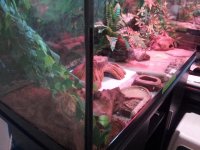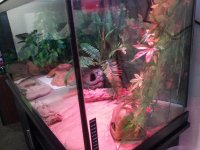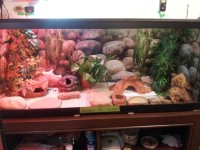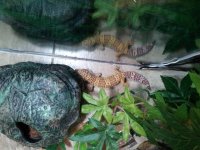You are using an out of date browser. It may not display this or other websites correctly.
You should upgrade or use an alternative browser.
You should upgrade or use an alternative browser.
This is my Males new tank. OPINIONS?
- Thread starter tr.73
- Start date
Oh yeah and let us not forget My females little stunt in the middle of all this craziness this morning.
I was in the middle of redoing this tank and moving the female and male around (switching tanks), and during the redoing of this tank the female was in a 10 gallon with just her dry hide/water/food dish....
She decided it was the perfect time to shed!!!!
so I had to get her moist hide in their with her while I finished the tank... what bad timing!!!!...
poor thing was probably stressed right out.
I put her in the other tank as soon as I got this one completed.
I will have to redo her tank at another time.... at least it should be faster as it already has everything. I am just adding tile to that tank.
I was in the middle of redoing this tank and moving the female and male around (switching tanks), and during the redoing of this tank the female was in a 10 gallon with just her dry hide/water/food dish....
She decided it was the perfect time to shed!!!!
so I had to get her moist hide in their with her while I finished the tank... what bad timing!!!!...
poor thing was probably stressed right out.
I put her in the other tank as soon as I got this one completed.
I will have to redo her tank at another time.... at least it should be faster as it already has everything. I am just adding tile to that tank.
kholtme
New member
Thats huge! Looks awesome. Are you going to add to it?
I would recommend getting something to go on the outside walls on the back and 2 sides. I just got some black poster boards and cut them to size and taped them on. But you could get those picture backgrounds, but may be expensive and hard to get them to line up with such a big tank. I like the black and think it looks better than seeing through the tank. It also will make your gecko feel more secure.
I would recommend getting something to go on the outside walls on the back and 2 sides. I just got some black poster boards and cut them to size and taped them on. But you could get those picture backgrounds, but may be expensive and hard to get them to line up with such a big tank. I like the black and think it looks better than seeing through the tank. It also will make your gecko feel more secure.
lol. It's not black... it is a background with a lot of dark plants/log/etc. I was gonna do a wrap around on 3 sides like the other 75g tank, but this tank sits on an angle from where I sit so I would not be able to see into it.
The other tank for the female has a wrap around 3 sides pic of a lot of rocks. (both geckos have spent hours looking at the background trying to figure out how to get in the crevices and under those rocks in the pic...lol. It is kinda mean to laugh but they do the same with the pick of the plants to, they try to figure out how they can crawl in behind them. so what can you do?...lol)
The other tank for the female has a wrap around 3 sides pic of a lot of rocks. (both geckos have spent hours looking at the background trying to figure out how to get in the crevices and under those rocks in the pic...lol. It is kinda mean to laugh but they do the same with the pick of the plants to, they try to figure out how they can crawl in behind them. so what can you do?...lol)
nope. it's a 75 gallon. I have 2. 1 for my male and 1 for my female.
That's great. Looks like a really cool home.
Thanks for the compliments.
I redo the females tank tomorrow.
She finally finished shedding...lol, but I am not doing it at this time of night..lol
We just finished laying down powder behind the fridge upstairs to get rid of cricket that got loose weeks ago...
I hope we got it and the darn thing is dead.... it has been keeping the bf awake at night...lol. (I sleep through it)
I redo the females tank tomorrow.
She finally finished shedding...lol, but I am not doing it at this time of night..lol
We just finished laying down powder behind the fridge upstairs to get rid of cricket that got loose weeks ago...
I hope we got it and the darn thing is dead.... it has been keeping the bf awake at night...lol. (I sleep through it)
Last edited:
nope still chasing the cricket..... grrrrr......
So here is a short story for you.....lol
I fed my geckos silkworms for the first time about a week ago. They would not eat anything after that. For 5 days we played the game of who will give in first.... the geckos? (give up and eat what I put in) or Me? (cave in and buy more silk and horn worms)... guess who won? spoiled little things. I could not handle them not eating anything...lol.
I waved a silkworm in front of the hide and out runs the gecko, in both cages they came running. But I did get the female to eat 1 silk, 1 horn, AND 1 king worm...(snuck that one in and she grabbed it before she realized what is was I think)...lol. The male only ate 1 silk and 1 horn...(then went back to his hide as usual). well at least they ate and it was a healthy food too...lol
So here is a short story for you.....lol
I fed my geckos silkworms for the first time about a week ago. They would not eat anything after that. For 5 days we played the game of who will give in first.... the geckos? (give up and eat what I put in) or Me? (cave in and buy more silk and horn worms)... guess who won? spoiled little things. I could not handle them not eating anything...lol.
I waved a silkworm in front of the hide and out runs the gecko, in both cages they came running. But I did get the female to eat 1 silk, 1 horn, AND 1 king worm...(snuck that one in and she grabbed it before she realized what is was I think)...lol. The male only ate 1 silk and 1 horn...(then went back to his hide as usual). well at least they ate and it was a healthy food too...lol
Shadow's Tank with a few modifications...



Pandora's Tank....



I have never seen my male out as much as I do now since he has tile instead of shelf liner. (The shelf liner had cold spots and "toooo hot" of spots). I am happy with the way that both 75 gallon tanks turned out. Temps are finally equal all across the floor on the warm sides and perfect in both tanks, and I can even turn the overhead (Red light) CHE off at night to give them true darkness again and the temps at 4am are 72-74F depending on house temps.



Pandora's Tank....



I have never seen my male out as much as I do now since he has tile instead of shelf liner. (The shelf liner had cold spots and "toooo hot" of spots). I am happy with the way that both 75 gallon tanks turned out. Temps are finally equal all across the floor on the warm sides and perfect in both tanks, and I can even turn the overhead (Red light) CHE off at night to give them true darkness again and the temps at 4am are 72-74F depending on house temps.
JIMI
New member
I have my leo in a 4 ft enclosure and his health seems to have only improved! Here's an excerpt from a scientific journal provided in one of the posts following Elizabeth's caresheet addressing this issue. Maybe, just maybe, it'll change your mind!
Assessing Reptile Welfare Using Behavioural Criteria
Journal of the British Veterinary Association...March 2013
Spatial considerations
"Many reptiles are mistakenly and inhumanely kept in small cages due to erroneous advice handed down from one pet trader, hobbyist or ill-informed keeper to another. Common false understandings are that many reptiles ‘feel safer’ in small environments and that they are naturally ‘sedentary and don’t need space'. This rationale may suit the convenience of those seeking to promote reptiles as a ‘cage pet’, but it is scientifically and ethically wrong.
While reptiles, like other animals, require shelter to which they can voluntarily withdraw, the key elements are that the animal seeks a ‘hiding place’ when it senses the need for it and it does this voluntarily. Imposing a confined space on an animal is biologically equivalent to trapping it.
Home range studies of reptiles have frequently shown them to be highly active and that they travel either within local ranges of several hundreds of square meters or indefinite ranges measured in hundreds or thousands of kilometres. For example, arboreal monitors have been documented moving daily ranges greater than 186 m, home ranges for some skink lizards are 1 ha, box turtles 40 ha, indigo snakes 158 ha, and for sea turtles, travel can be measured in the thousands of kilometres.
Small species and juveniles commonly utilize as much, and sometimes more, total space than large species and adults. Smaller forms are often insectivorous and these may need to feed more frequently than larger forms and also require a great deal of activity to track and catch their highly active prey.
Regardless of these differences, all reptiles are active, including species such as pythons that are popularly, but wrongly, perceived as sedentary. Some species, in particular large carnivores such as monitor lizards and pythons, may adopt brief sedentary periods following consumption of large meals, but this is a transient phase and not one that should be used to judge an animal's general activity pattern or spatial needs."
Assessing Reptile Welfare Using Behavioural Criteria
Journal of the British Veterinary Association...March 2013
Spatial considerations
"Many reptiles are mistakenly and inhumanely kept in small cages due to erroneous advice handed down from one pet trader, hobbyist or ill-informed keeper to another. Common false understandings are that many reptiles ‘feel safer’ in small environments and that they are naturally ‘sedentary and don’t need space'. This rationale may suit the convenience of those seeking to promote reptiles as a ‘cage pet’, but it is scientifically and ethically wrong.
While reptiles, like other animals, require shelter to which they can voluntarily withdraw, the key elements are that the animal seeks a ‘hiding place’ when it senses the need for it and it does this voluntarily. Imposing a confined space on an animal is biologically equivalent to trapping it.
Home range studies of reptiles have frequently shown them to be highly active and that they travel either within local ranges of several hundreds of square meters or indefinite ranges measured in hundreds or thousands of kilometres. For example, arboreal monitors have been documented moving daily ranges greater than 186 m, home ranges for some skink lizards are 1 ha, box turtles 40 ha, indigo snakes 158 ha, and for sea turtles, travel can be measured in the thousands of kilometres.
Small species and juveniles commonly utilize as much, and sometimes more, total space than large species and adults. Smaller forms are often insectivorous and these may need to feed more frequently than larger forms and also require a great deal of activity to track and catch their highly active prey.
Regardless of these differences, all reptiles are active, including species such as pythons that are popularly, but wrongly, perceived as sedentary. Some species, in particular large carnivores such as monitor lizards and pythons, may adopt brief sedentary periods following consumption of large meals, but this is a transient phase and not one that should be used to judge an animal's general activity pattern or spatial needs."
Last edited:

















